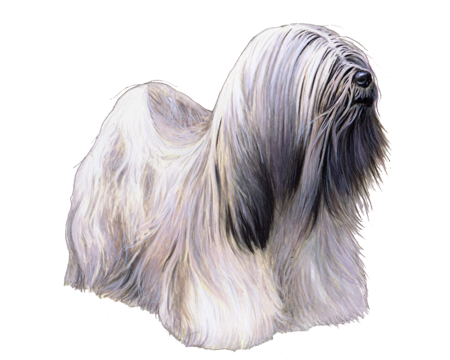
Tibetan Spaniel
Though small in stature, Tibetan Spaniels rise to the roles of watchdogs and devoted, faithful companions.
Interested in discovering if your dog is a Tibetan Spaniel?
Check out Wisdom Panel's DNA tests.

Tibetan Spaniel Traits
General Appearance
Tibetan Spaniels are small, active, alert dogs with well-balanced appearances, and quick-moving gaits.
Coat and Colouring
These double-coated dogs have moderate-length, silky hair covering their bodies; it is smooth on the face and front legs, where it lies flat. The hair is feathered on the ears and back of the forelegs, while longer and well-furnished on the tail and buttocks. The neck is covered with a mane of longer hair that is more pronounced on males than females.
When showing a Tibetan Spaniel, the hair must be unaltered; the coat should lie naturally with no teasing, parting, or styling; the feathering on the toes must not be trimmed but hair growing between the pads on the underside of the feet can be trimmed.
All colors and mixtures of colors are allowed with the most common being black, black and tan, cream, gold, red, sable, white, and silver sable with parti-color or white markings.
Distinctive Physical Traits
Tibetan Spaniels are more long than tall (but should not be too long-bodied or low to the ground). The breed has a small head with dark brown, oval-shaped, expressive eyes set far apart. Its medium-sized, pendant-shaped ears are set high and well-feathered. Its medium-length, blunt muzzle is free from wrinkles. The tail is also set high, richly plumed, and makes a gay curl over their backs.
Tibetan Spaniel Temperament
Tibetan Spaniels are assertive, intelligent, and self-confident. They have independent spirits and value their roles as watchdogs but also form close bonds with their owners and make friendly, playful companions. Tibetan Spaniels can be aloof with strangers.
Thanks to centuries of working as watchdogs, Tibetan Spaniels have keen senses of hearing and sight. They bark as a warning that a stranger is approaching but do not bark without reason and are quiet enough for apartment living. The breed is adaptable to most lifestyles, including homes with other pets.
Tibetan Spaniels are sensitive companion animals that want to be with their owners and will be unhappy when left alone for too long.


Tibetan Spaniel History
The Tibetan Spaniel is a native Tibetan dog breed that may have shared ancestry with the Japanese Chin and Pekingese. It is one of three native Tibetan breeds in the non-sporting group.
The ancient breed traces its roots to Buddhist monasteries where monks kept the so-called Tibbies as companions and watchdogs more than 3,000 years ago. Tibetan Spaniels could be found sitting atop temple walls and scanning the surrounding countryside. Local lore says the dogs even turned prayer wheels for the monks. In addition to being an excellent watchdog, the Tibetan Spaniel was also a favorite companion.
In Tibet, where lions are considered sacred, the Tibetan Spaniel’s lion-like appearance made the breed highly regarded; these dogs were often given as gifts to palaces in Buddhist countries.
Tibetan Spaniel Care
Nutrition
Feed Tibetan Spaniels a high-quality dog food that is appropriate for their life stage (puppy, adult, senior) and consider a diet formulated for small breeds. Portion out their food with a standard measuring cup and limit treats to no more than 10% of their daily calories to prevent overfeeding.
Grooming
Tibetan Spaniels have minimal grooming requirements. Regular brushing (with special attention to the longest hair behind their ears and on their rear fringes) can keep painful mats from forming. Groomers must be advised not to cut the hair on their bellies or between their legs—called a sanitary cut—because it can cause severe itchiness. Occasional baths will minimize shedding and keep them looking and smelling great.
Nail trims, ear cleaning, and dental care, including at-home teeth-brushing and professional cleanings, are also essential for good grooming.
Exercise
Tibetan Spaniels do not need a lot of exercise. A daily walk or time to explore a fenced yard will suffice for these dogs but, given the chance, Tibetan Spaniels will also take part in more active pursuits such as agility, scent work, rally, and obedience. Once their workout is done, their favorite thing is a perch that allows them to look out over their territories and take in the surroundings.
Training
Tibetan Spaniels are alert, smart, and eager to please but also have stubborn, independent streaks. While they can be easy to train, these dogs may not want to follow instructions. Since Tibetan Spaniels can be sensitive, they respond best to positive reinforcement and rewards-based training, not harsh commands. Regular socialization is important to help Tibetan Spaniels feel confident around strangers.

Tibetan Spaniel Genetic Health Conditions
-
Chondrodystrophy (CDDY) and Intervertebral Disc Disease (IVDD) Risk
Chondrodystrophy (CDDY) is a skeletal disorder characterized by shortened limbs and abnormal early degeneration of the spinal discs, or intervertebral disc disease (IVDD), which predisposes to disc herniation.
-
Progressive Retinal Atrophy Type III
Progressive Retinal Atrophy (PRA) is a disorder that causes the degeneration of the light sensing retina at the back of the eye, resulting in vision loss.
Knowing if your Tibetan Spaniel is a carrier or at-risk for these conditions can help you and your veterinarian plan for your pup's lifelong care. With Wisdom Panel™ Premium, you can get results for over 200 genetic health tests.
Breed Group
Companion
This group consists of dogs typically bred for the specific purpose of human companionship, and many are popular pets because of their gentle nature. They became more common as the concept and luxury of dogs as pets prevailed.
Resources
https://www.akc.org/dog-breeds/tibetan-spaniel/
http://images.akc.org/pdf/breeds/standards/TibetanSpaniel.pdf
https://www.tsca.ws/aboutthebreed/
Reviewed 26 July 2020 by Cindy Elston, DVM, MPH



























_Color.png)










